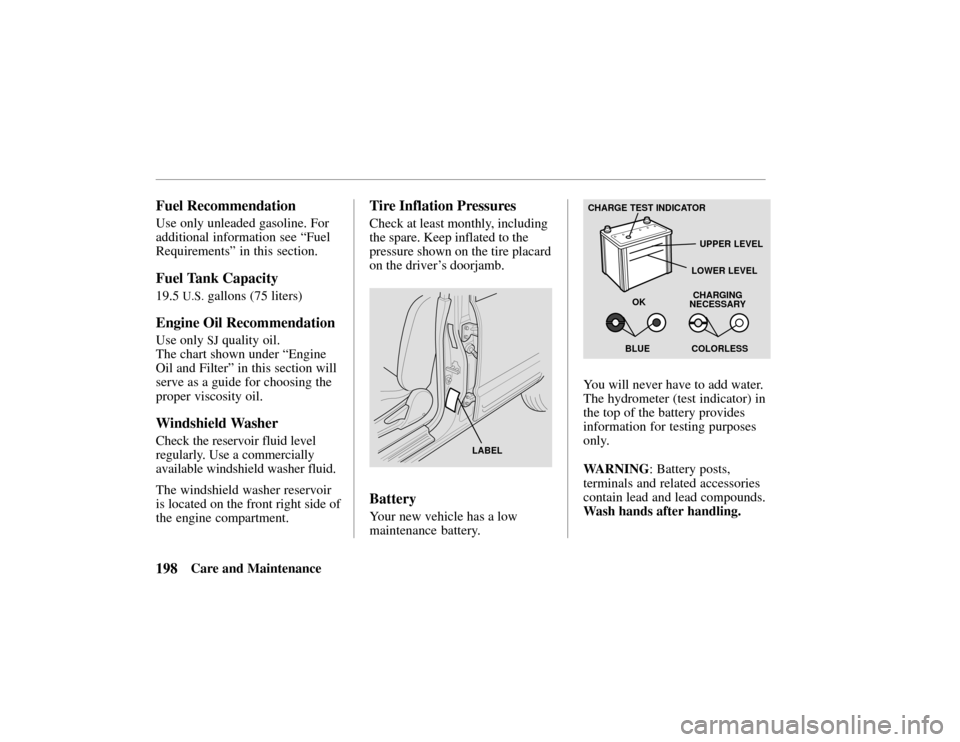2002 HONDA PASSPORT spare tire
[x] Cancel search: spare tirePage 167 of 294

164Driving Tips
Inflation
Keeping the tires properly inflated
provides the best combination of
handling, tread life, and riding
comfort. Underinflated tires wear
unevenly, adversely affect handling
and fuel economy, and are more
likely to fail from being overheated.
Overinflated tires can make your
vehicle ride more harshly, are
more prone to damage from road
hazards, and wear unevenly.
We recommend that you visually
check your tires every day. If you
think a tire might be low, check it
immediately with a tire gauge.
Use a gauge to measure the air
pressure at least once a month.
Even tires that are in good
condition may lose one to two psi
per month. Remember to check
the spare tire at the same time you
check all the other tires.Check the pressure in the tires
when they are cold. This means
the vehicle has been parked for at
least three hours. If you have to
drive the vehicle before checking
the tire pressure, the tires can still
be considered “cold” if you drive
less than 1 mile (1.6 km).
If you check the pressure when
the tires are hot (the vehicle has
been driven several miles), you
will see readings 4 to 6 psi (28 to
41 kPa, 0.3 to 0.4 kg/cm
2) higher
than the cold reading. This is
normal. Do not let air out to
match the specified cold pressure.
The tire will be underinflated.
You should get your own tire
pressure gauge and use it at all
times. That makes it easier for
you to tell if a pressure loss is
caused by a tire problem and not a
variation between gauges. Recommended Tire Pressures for
Normal Driving
The following chart shows the
recommended cold tire pressures
for most normal driving
conditions and speeds.
Tire SizeCold Tire Pressure for
Normal Driving
225/75R1629psi (200 kPa)225/75R1629 psi (200 kPa)
245/70R1626 psi (180 kPa)
Page 189 of 294

186 In Case of Emergency
6.
Start the engine of the vehicle
that has the discharged battery.
7. Remove the battery cables by
reversing the above sequence
exactly. Start by removing the
last clamp first; that is,
remove the jumper cable from
the engine of the vehicle with
the discharged battery as the
first step. If you have a flat tire while
driving, stop in a safe place to
change it. Stopping in traffic or on
the shoulder of a busy road is
dangerous. Drive slowly along the
shoulder until you get to an exit or
an area to stop that is far away
from the traffic lanes.
The vehicle can easily roll off
the jack, seriously injuring
anyone underneath.
Follow the directions for
changing a tire exactly, and
never get under the vehicle
when it is supported only by
the jack.
1.
Park on a level surface and set
the parking brake firmly. Turn
on the hazard warning flasher,
and turn the ignition switch to
LOCK.
2. Set the automatic transmission
in “Park” (the manual
transmission in “Reverse”)
and transfer case in gear if it
is a four-wheel drive vehicle.
3. Have your passengers get out
of the vehicle.
4. Remove the jacking tools (see
page 188) and spare tire from
their stowage areas.
Changing a Tire
Page 191 of 294

188In Case of Emergency
8. Turn the jack handle
clockwise with a slow, smooth
motion to raise the vehicle so
the inflated spare tire will
clear the surface.
9. Remove the wheel nuts and the wheel.
10. Install the wheel and replace the wheel nuts with the
cone-shaped end toward the
wheel, then hand-tighten each
nut. The wheel must be seated
on the hub.
11. Lower the vehicle by turning the jack handle counter-
clockwise, then fully tighten
the wheel nuts in a crisscross
sequence by turning the
wrench clockwise. Have the
wheel nut torque checked at
the nearest automotive service
facility.
87 lb-ft (118 N·m) 12. Stow the jacking tools and flat
tire in their proper locations.
EX model
Use the screwdriver to remove the
center cap from the wheel before
stowing the flat tire.
Loose items can fly around the
interior in a crash and could
seriously injure the occupants.
Store the wheel, jack, and
tools securely before driving.
The jack is stored in a
compartment on the driver ’s side
rear wheel panel.
To remove the jack from its
compartment, turn the handle
counterclockwise. Disconnect the
hold-down strap.
Tool Locations
Page 192 of 294

189In Case of Emergency
The tire wrench and jack handle
are concealed under the right rear
seat cushion.
UNDERSIDE
OF RIGHT REAR
SEAT CUSHION
TIRE WRENCH AND JACK HANDLE
The screwdriver is stored in a
pouch under the left rear seat
cushion.
LX model
The spare tire is mounted on the
rear door. To remove it, unlock
the spare tire lock (if so
equipped). Use the wheel wrench
to remove the retaining bolts.
When replacing the spare tire,
make sure you put it on the carrier
with the outside of the wheel
facing out. Tighten the bolts
securely.
EX model
The spare tire is stored under the
cargo area floor. To lower it, open
the rear door. Insert the jack
handle between the body and the
top of the rear bumper. Insert the
end of the jack handle into the slot
in the tire winch, then turn the
handle counterclockwise to lower
the tire. Lower the tire to the
ground, then remove the bracket
in the center of the wheel.
Spare Tire Removal
Page 193 of 294

190In Case of Emergency
Reverse this procedure to store
the spare tire. Connect the spare
tire to the bracket with the outside
of the wheel facing up. Make sure
the tire does not catch on any part
of the underbody of the vehicle as
you are raising it, and that the
spare tire is stored securely before
driving.
If the engine overheats:
•The engine coolant temperature
gauge pointer will move up to
the
“
H” or higher.
•Engine “ping” will become
excessive.
•Loss of engine power will be
noticed.
•Either steam or boiling water
will squirt out of the radiator.
If you find that the engine is
overheating:
•Stop the vehicle, and turn on
the hazard warning lights.
•If you see or hear steam or
coolant coming from the
engine compartment, turn off
the engine immediately.
Steam and spray from an
overheated engine can
seriously scald you.
Do not open the hood if steam
is coming out.
•
If you do not see or hear steam
or spray, turn off the
A/C (if
on) and run the engine at a
speed slightly higher than idle
speed (about 1,500 rpm) for
several minutes. Watch the
coolant temperature gauge. If it
remains at the “
H” mark, turn
off the engine.
•Open the hood only after all
signs of steam or hot coolant
spray have stopped. Look for
signs of an obvious leak, such
as a split radiator hose. If you
Engine Overheating
Page 201 of 294

198Care and Maintenance
Fuel Recommendation
Use only unleaded gasoline. For
additional information see “Fuel
Requirements” in this section.
Fuel Tank Capacity
19.5 U.S. gallons (75 liters)
Engine Oil Recommendation
Use only SJ quality oil.
The chart shown under “Engine
Oil and Filter” in this section will
serve as a guide for choosing the
proper viscosity oil.
Windshield Washer
Check the reservoir fluid level
regularly. Use a commercially
available windshield washer fluid.
The windshield washer reservoir
is located on the front right side of
the engine compartment.
Tire Inflation Pressures
Check at least monthly, including
the spare. Keep inflated to the
pressure shown on the tire placard
on the driver’s doorjamb.
LABEL
Battery
Your new vehicle has a low
maintenance battery.
CHARGE TEST INDICATOR
UPPER LEVEL
LOWER LEVEL CHARGING
NECESSARY
OK
BLUE COLORLESS
You will never have to add water.
The hydrometer (test indicator) in
the top of the battery provides
information for testing purposes
only.
WARNING : Battery posts,
terminals and related accessories
contain lead and lead compounds.
Wash hands after handling.
Page 211 of 294

208 Care and Maintenance
Promptly take any safety
problems to your Honda dealer
for service advice.
Parking
brake — Park on a fairly
steep hill and hold the vehicle
with the parking brake only. This
checks its holding ability.
Starter safety switch (automatic
transmission) —
Check the safety
switch by trying to start the
engine in each gear. The starter
should work only with the shift
lever in the “P” (Park) or “N”
(Neutral) position.
Starter safety switch (manual
transmission) —
To check the
safety switch, place the shift lever
in “Neutral,” push the clutch
pedal halfway and try to start the
engine. The starter should not
work. The starter should work only when the clutch pedal is fully
depressed.
Transmission shift indicator
(automatic transmission)
—
Check that the indicator points to
the gear chosen.
Steering — Be alert for any
changes in steering action. An
inspection or service is needed
when the steering wheel is harder
to turn or has too much free play,
or if there are unusual sounds
when turning or parking.
Wheel alignment, balance and
tires —
Uneven or abnormal tire
wear, or pulling to the right or left
on a straight and level road may
show the need for a wheel
alignment. A vibration of the
steering wheel or seat at normal
highway speeds means wheel balancing is needed. Check tire
pressures (including the spare) at
least monthly and whenever the
vehicle is serviced (see page 163).
Brakes — Watch for the
“
BRAKE” light coming on. Other
signs of possible brake trouble are
such things as repeated pulling to
one side when braking, unusual
sounds when braking or between
brake applications, or increased
brake pedal travel. If you note one
of these conditions, have the
system checked at once and
repaired if needed.
Owner Safety Checks
Page 213 of 294

210Care and Maintenance
Seat-back latches — Seat-back
latches are designed to prevent
forward motion of the seat-back
when the vehicle stops suddenly.
Check to see that the seat-back
latches are holding by pulling
forward on the top of the folding
seat-back.
Also check to see that the
reclining seats are operating
properly.
Lights and beepers — Check
panel lighting, warning lights, and
the seat belt reminder light and
beeper. Also check the key beeper
and interior lights. On the outside,
check the license plate light, side
marker lights, headlights, parking
lights, taillights, brake lights, turn
signals, backup lights and hazard
warning flashers. Have the
headlight aim checked promptly if the beams seem to be aimed
improperly.
Glass — Check for broken,
scratched or damaged glass that
could reduce visibility or cause
injury.
Door latches — Check that the
doors close, latch and lock
securely.
Hood latch — Check that the
hood closes firmly. Check for
broken, damaged, or missing parts
that might prevent secure
latching. Make sure the secondary
latch keeps the hood from
opening all the way when first
released.
Fluid leaks — Check for fuel,
water, oil or other fluid leaks by
looking at the surface beneath the
vehicle after it has been parked
for awhile. Water dripping from
the air conditioning system after
use is normal. If you notice
gasoline fumes or fluid at any
time, locate the source and have it
corrected at once.
Spare tire and jack — Check that
the spare tire and all jack gear are
securely stowed at all times.
Tailgate latch — Check that the
tailgate closes, latches and locks
securely.